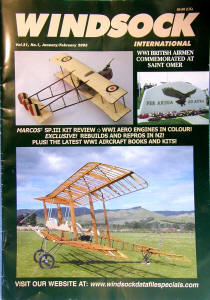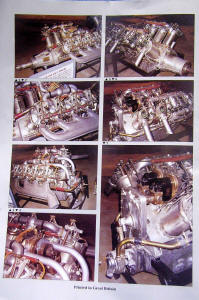|
Albatros Productions Ltd. |
|
Windsock International Volume 21, Number 1, January/February 2005 |
|
by |
|
Reviewed By Mark McGovern, #34707 |
|
There’s a connotation to the word "extreme" these days, which suggests an interest in a subject that borders on the suicidal. As
in, an "extreme" snowboarder, who will jump out of a helicopter and descend the Matterhorn by sliding on a few square feet of
fiberglass. It is in this context that I would use the word "extreme" to describe the mavens of World War I aviation who staff
Great Britain’s Windsock International. Unless you’re a regular reader of this magazine (in which case, the word "extreme" as defined above will probably apply to you, too), you may only have been aware of it from ads in U.S. hobby periodicals, or seen copies of it or its offshoot publication, Windsock Datafiles, in stacks on the vendors’ tables at model shows. That was my experience with the magazine. When this particular issue came up for review, with its focus on WW I aircraft engines, I volunteered to look at it because I’ve been thinking about tackling a stringbag myself. WELL! This is no "walk around" type of book. You can see from the cover photos that the folks at Windsock aren’t in it just for the models – they’re just as interested in the real thing. There’s coverage of the Royal Aircraft Factory of New Zealand’s reconstruction of a BE2e (including the authentic reproduction of its engine from surviving parts), an SE-5a, and a DH5. Another article examines "German WWI Aero Engines in the UK 1912-1920". Plus the Editor/Publisher/Founder, Ray Rimell, sticks in nifty tidbits such as an excerpt from a maintenance handbook, showing how to properly attach fuselage-bracing wires. The back cover features eight nice ‘colour’ close-ups of a Curtiss OX-5 eight cylinder ‘V’ and a Standard OXX-6 engine; ironically, the photos were taken at the US Air Force Museum in Dayton, Ohio! On to the modeling: the inside front cover ran eight color pictures of two excellent models. There’s a look back at vintage kits in the "Gone West" Kit Collectors’ Column. Pedro Nuno Soares shared his experiences building a resin Savoia Pomillo SP. III. This includes the rigging of the 1/72 scale model. Sixteen of the accompanying photos were in color. And what modeling magazine could exist without a section devoted to the review of new kits and hobby products? Windsock covers that as well. There are 34 pages, cover to cover – not even half an issue of most American periodicals. The type font is smaller, and there are fewer photos. But don’t get me wrong – this is a case where less is definitely more. The letters to the editor feature, "Propwash", runs material from correspondents that seemed pretty long by US standards but also very learned. I also enjoyed the "Logbook" section, which reviewed a couple of WWI historical works. In one instance the reviewer (Mr. Rimell, I believe) found fault with the book and didn’t hesitate to say so! This magazine covers the history of its subject as much as the modeling of it. After reading just one issue, I guarantee you’ll know what "CDL" means! Windsock and its associated publications are available in the U.S. through Wise Owl Worldwide Publications, 5150 Candlewood Street, Suite #1, Lakewood, California 90712-1900. You can phone them at (562) 461-7574 or fax: (562) 461-7212. Their web site is at www.WiseOwlMagazines.com and email is info@wiseowlmagazines.com. T hank you, John Noack, for sending me this nifty magazine for review. …Okay, "CDL" stands for "clear doped linen", a light beige color. |
|
Information, images, and all
other items placed electronically on this site |

